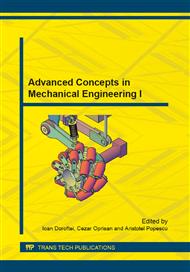[1]
R.G. Burdett, R. Habasevich, J. Pisciotta, S.R. Simon, Biomechanical comparison of rising from two types of chairs. Phys Ther, 65 (1985) 1177–1183.
DOI: 10.1093/ptj/65.8.1177
Google Scholar
[2]
O. Eriksrud, R.W. Bohannon. Relationship of knee extension force to independence in sit-to-stand performance in patients receiving acute rehabilitation. Phys Ther. 83 (2003) 544–551.
DOI: 10.1093/ptj/83.6.544
Google Scholar
[3]
M.A. Hughes, B.S. Myers, M.L. Schenkman, The role of strength in rising from a chair in the functionally impaired elderly. J Biomech. 29 (1996) 1509–1513.
DOI: 10.1016/s0021-9290(96)80001-7
Google Scholar
[4]
P. Dehail, E. Bestaven, F. Muller, et al. Kinematic and electromyographic analysis of rising from a chair during a Sit-to-Walk, task in elderly subjects: role of strength. Clin Biomech (Bristol, Avon) 22 (2007) 1096–1103.
DOI: 10.1016/j.clinbiomech.2007.07.015
Google Scholar
[5]
D.W. Vander Linden, D. Brunt, M.U. McCulloch, Variant and invariant characteristics of the sit-to-stand task in healthy elderly adults. Arch Phys Med Rehabil. 75 (1994) 653–660.
DOI: 10.1016/0003-9993(94)90188-0
Google Scholar
[6]
T. Yamada, S. Demura, Relationships between ground reaction force parameters during a sit-to-stand movement and physical activity and falling risk of the elderly and a comparison of the movement characteristics between the young and the elderly, Arch Gerontol Geriatr. 48 (2009).
DOI: 10.1016/j.archger.2007.10.006
Google Scholar
[7]
M. Hirvensalo, T. Rantanen, E. Heikkinen, Mobility difficulties and physical activity as predictors of mortality and loss of independence in the community-living older population. J Am Geriatr Soc. 48 (2000) 493–498.
DOI: 10.1111/j.1532-5415.2000.tb04994.x
Google Scholar
[8]
G. Janssen, B. Bussmann, H. Stam, Determinants of the sit-to stand movement: a review. Phys Ther. 82 (2002) 866–879.
DOI: 10.1093/ptj/82.9.866
Google Scholar
[9]
M. Galli, V. Cimolin, M. Crivellini, I. Campanini, Quantitative analysis of sit to stand movement: experimental set-up definition and application to healthy and hemiplegic adults. Gait Posture, 28 (2008) 80–85.
DOI: 10.1016/j.gaitpost.2007.10.003
Google Scholar
[10]
S.R. Lord, S.M. Murray, K. Chapman, et al. Sit-to-stand performance depends on sensation, speed, balance, and psychological status in addition to strength in older people. J Gerontol A Biol Sci Med Sci. 57 (2002) M539–M543.
DOI: 10.1093/gerona/57.8.m539
Google Scholar
[11]
D. Dawson, G. Hendershot and Fulton, J. (1987) Aging in the eighties. Functional limitations of individuals age 65 and over. Advance Data From Vital and Health Statistics 133, DHHS-PHS-87-1250.
DOI: 10.1037/e605432007-001
Google Scholar
[12]
M.W. Rodosky, T.P. Andriacchi, G.B.J. Andersson: The Influence Of Chair Height On Lower-Limb Mechanics During Rising. Journal of Orthopaedic Research 7 (1989) 266-271.
DOI: 10.1002/jor.1100070215
Google Scholar
[13]
W.A. Hodge, K.L. Carlson, R.S. Fijan, R.G. Burgess, P.O. Riley, W.H. Harris, R.W. Mann: Contact Pressures From An Instrumented Hip Endoprosthesis. Journal of Bone and Joint Surgery American Volume 1989, 71A (1989) 1378-1386.
DOI: 10.2106/00004623-198971090-00015
Google Scholar
[14]
D. Tarnita, M. Catana, D.N. Tarnita, Nonlinear analysis of normal human gait for different activities with application to bipedal locomotion, Ro J Tech Sci. Appl. Mech., 58(1–2) (2013) 27–42.
Google Scholar
[15]
L. Jiyun, C. Jiaxun, A mannequin modeling method based on section templates and silhouette control, International Journal of Clothing Science and Technology, 21: 5, (2009) 300-310.
DOI: 10.1108/09556220910983795
Google Scholar
[16]
I. Geonea, C. Alexandru, Design and Simulation of a Single DOF Human-Like Leg Mechanism, Applied Mechanics and Materials, 332, (2013) 491-496.
DOI: 10.4028/www.scientific.net/amm.332.491
Google Scholar


